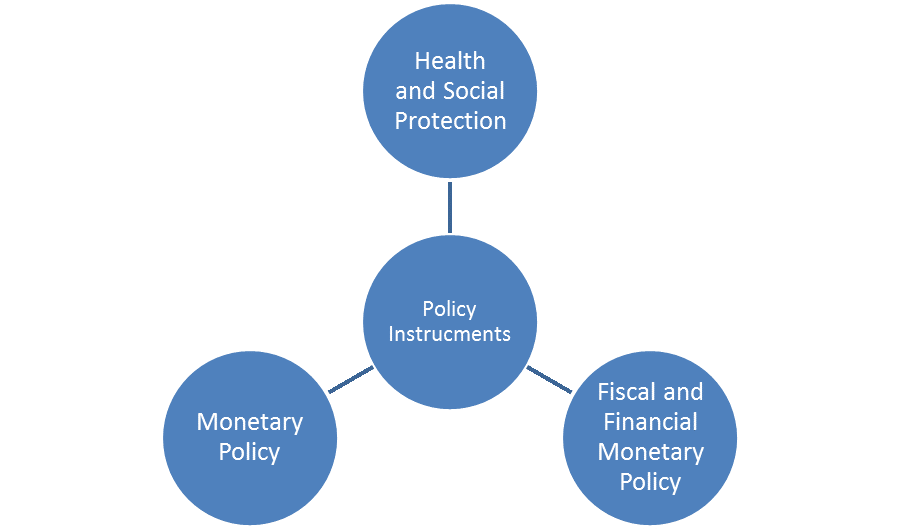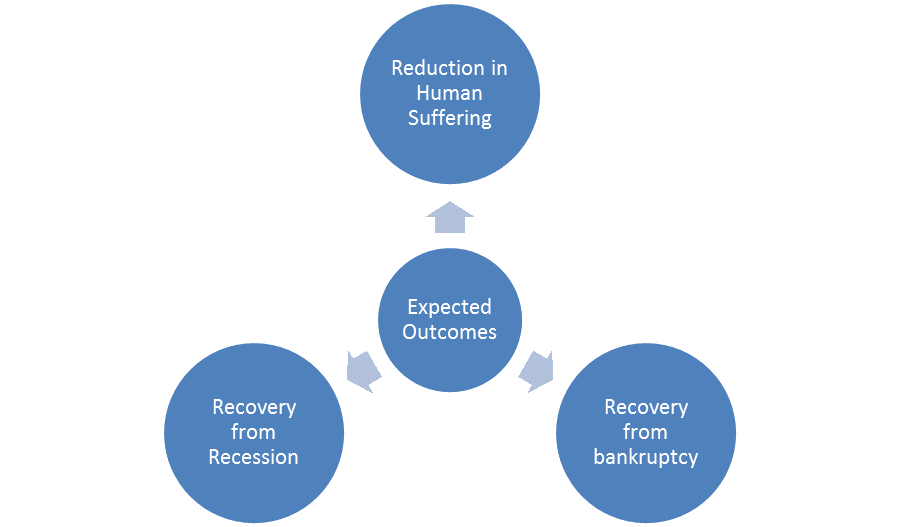Covid-19 and the Nigerian Economy

Introduction
A cursory glance at the recent developments on COVID-19 reveals that since December 2019, the virus has spread to nearly every continent in the world, and case numbers have continued to rise. There are authoritative reports from 211 countries and territories reporting that more than 2,463,000 novel COVID-19 cases worldwide i have emerged since China reported its first cases to the World Health Organization (WHO) in December 2019. Humanity will never forget December 2019 when the strange virus emerged. Since then, it threatens to become one of the most difficult tests faced by humanity in modern history, with a huge potentiality to take lives, overwhelm health systems, and trigger lasting geopolitical change.
According to the report of the European Centre for Disease Prevention and Control (ECDC), by 20th of April 2020, Africa had 22 303 cases; the five countries reporting most cases are South Africa (3 158), Egypt (3 144), Morocco (2 855), Algeria (2 629) and Ghana (1 042). Asia had 378 985 cases; the five countries reporting most cases are Turkey (86 306), China (83 817), Iran (82 211), India (17 265) and Israel (13 491). America had 899 051 cases; the five countries reporting most cases are United States (759 687), Brazil (38 654), Canada (34 777), Peru (15 628) and Chile (10 088). Europe had 1 046 854 cases; the five countries reporting most cases are Spain (195 944), Italy (178 972), Germany (141 672), United Kingdom (120 067) and France (112 606). Oceania had 7 964 cases; the five countries reporting most cases are Australia (6 612), New Zealand (1 105), Guam (136), French Polynesia (55) and New Caledonia (18), with other 696 cases reported from an international conveyance in Japan ii.
According to the same report, Africa had recorded 1 120 deaths; the five countries reporting most deaths are Algeria (375), Egypt (239), Morocco (141), South Africa (54) and Cameroon (42). Asia had 14 663 deaths; the five countries reporting most deaths are Iran (5 118), China (4 636), Turkey (2 017), Indonesia (582) and India (543). America had 47 369 deaths; the five countries reporting most deaths are United States (40 682), Brazil (2 462), Canada (1 580), Mexico (686) and Ecuador (474). Europe had 101 408 deaths; the five countries reporting most deaths are Italy (23 660), Spain (20 453), France (19 718), United Kingdom (16 060) and Belgium (5 683). Oceania had 89 deaths; the four countries reporting most deaths are Australia (70), New Zealand (12), Guam (5) and Northern Mariana Islands (2). Other 7 deaths were reported from an international conveyance in Japan iii.
With these developments of ill-health, deaths and restrictions of movements to curtail the spread of the virus, the consequence on the economy of Africa and Nigeria in particular would obviously be disastrous. This piece would focus on how COVID-19 has affected the Nigerian economy. It would further make suggestions on the way forward towards boosting the Nigerian economy.
The Economic Impact of COVID-19
The International Monetary Fund Report in 2020 observes that in the face of COVID-19 pandemic, the global economy faces its worst downturn since the Great Depression. Following the IMF, the Oxfam International in her 2020 report warned that half a billion people could be pushed into poverty as a result of the COVID-19 pandemic. With particular reference to Nigeria, the question looming at the horizon is: how is the pandemic affecting her economy? A cursory glance at the Nigerian economy reveals that there are three major impacts that COVID-19 is already having. Each of the three impacts is very devastating. However, having the three of them at a time, with their mutually reinforcing character, their threat to any economy can be terrible.
- COVID-19 has led to economic suffering in Nigeria, through loss of jobs and other incomes. As small and medium-sized enterprises are hammered by the lockdown, many workers have lost their jobs while many are working on reduced work schedules.
- The situation is gradually dragging the Nigerian economy deeper and deeper into recession. It is more challenging for Nigeria as she is still sluggishly grappling with recovery from the 2016 economic recession which was a fall out of global oil price crash and insufficient foreign exchange earnings to meet imports iv.
- The financial and corporate sectors in Nigeria are beginning to suffer deterioration. Markets have taken a big hit, financial systems are under stress and banks are likely to see huge pressures on their balance sheets. Private firms are hurt by the collapse in demand. The likelihood of large-scale bankruptcies is rising.
On the way forward
The consequence of the COVID-19 pandemic on the Nigerian economy is one that the nation will have to grapple with for years to come. However, the policy response will go a long way in determining how long it would last. If it is late, weak, or uncoordinated, the devastating consequences would last longer. However, if the response is prompt, strong and coordinated, it would be less devastating. For the policies to be coordinated, it must be multidimensional, bold, and unbound by convention.
- As a way forward, the immediate focus of the nation should be on measures to contain the spread of the disease and to treat the infected. The ability to stop its spread and treat the sick will have very positive consequences on the economy.
- Nigeria will need to bring together quality minds who would sit together and develop an economic model that is peculiar to the present situation and capable of saving the economy of the nation. This economic team will have to be selected not on the basis of ethnicity, religion or political party, but on the basis of competence. That is, if anything positive is to be expected from the team.
- The time has come to focus on developing the local economy with the hope of having a nation that is dependent on local goods rather than over-dependence on importation. Africa has depended on finished goods from Europe, America, China, etc., goods such as toothpick, face masks, ventilators, foodstuff, etc. At this time of COVID-19, when it has become difficult to import goods from other countries, countries like Nigeria, should start producing some of these things for her citizens. Interestingly, face masks and ventilators are beginning to be produced in Aba, Cross River and Anambra States.
- To save the economy, companies and other establishments relieving workers of their job is not the solution to the problem; while it presents itself as a temporal solution to the particular establishment, wholistically viewed, it creates another problem. We have always talked about employees’ loyalty to the employer, this is the time to emphasize the importance of employers’ loyalty as well. The quality of loyalty that an employer shows the employee at a moment like this has great consequences for the future of the company or establishment. There should be more of negotiation than relieving employees of their jobs.
- Movement at this time, especially of persons is very difficult as a result of the total lockdown in most states. To drive the economy, establishments will have to explore alternatives, like online engagements. This is not only for businesses but also for the educational sector. People should be able to run online educational packages from home. They should be able to shop and have it delivered to them at home. People should be able to consult a medical doctor online during an emergency.
- To boost the economy, the Federal government needs to intervene in the area of Small and Medium-Sized Enterprises (SME). These SMEs are significant as they contribute to economic development of the nation through their assets, revenues and employees. With COVID-19 threatening their existence, many who work with them will be going home without salary, may be for the second month. Some are already running serious losses unlike bigger establishments that have reserves to keep them going. For the economy to survive at this time, the government needs to bail out these SMEs.
- To protect the economy, there might be the need to look at the cost of governance. No system can maintain a large board at a time like this. No economy can make serious progress when its running cost is on the lead of other costs.
- There is the need to plead for the suspension of servicing or cancelation of international debts. In this way, the local economy would be given the breathing space to recover from the economic depression which COVID-19 pandemic has created.
- The Nigerian government must lead economic diversification drive. It is obvious that the one-tracked, monolithic reliance on oil has failed. Diversification priorities would lead to alternative economic sectors such as agriculture, solid minerals, manufacturing and services sectors v. The fact that Nigeria is already looking distressed only after two months of crash in oil price, unlike her top oil producing counterparts like Saudi Arabia, Russia, etc., who are looking good to survive without oil, makes it clear that diversification is not an option if Nigeria must survive economically.
- The government will need to pay the salaries of workers at this time. Nations across the world are voting trillions of dollars to cushion the effect of COVID-19 lockdown on their citizens. The United States, Britain, South Korea, Japan, Italy, Spain, and even Ghana are doing this for their citizens. To keep citizens under lockdown and still deny them of their salaries for 2 to 3 months will not make any head way as economic development is wholistic.
All the above points can be grouped under three main policy instruments:
Policy Instruments for Mitigating the Impact of COVID-19 on the Economy

Figure 1
The first is health and social protection. It includes government policies regarding testing, treatment, hiring new medical staff, expanding social assistance and implementing cash transfers to households, etc. The second is Fiscal policy, which includes efforts on revenue collection, spending and financing of the larger fiscal deficit. The third is Financial, industrial, and trade policies, which cover providing liquidity to solvent banks, bank forbearance on domestic private loans, reductions in collateral requirements, canceling unnecessary procedures for firm registration, and reducing import restrictions and tariffs vi.
If the policy instruments presented in Figure 1 are administered, Figure 2 tells of the expected outcomes from the administration of the policy instruments.
Expected Outcomes from the Implementation of Policy Instruments for Mitigating the Impact of COVID-19 on the Economy

Figure 2
The beauty of this is that the policy instruments must be administered concurrently, and only within this context is she able to bring about a wholistic expected outcome that reduces human suffering, enhances the recovery of the economy from bankruptcy and recession.
- Henrik Pettersson, et al, 2020. Tracking coronavirus’ global spread. CNN HEALTH. Retrieved 21 April from https://edition.cnn.com/interactive/2020/health/coronavirus-maps-and-cases
- ECDE Report 2020, Retrieved 21 April 2020 from https://www.ecdc.europa.eu/en/geographical-distribution-2019-ncov-cases
- ECDE Report 2020, Retrieved 21 April 2020 from https://www.ecdc.europa.eu/en/geographical-distribution-2019-ncov-cases
- Lateef, O. A and Samiel C. G., 2020. The implication of Covid’19 on the Nigerian Economy. CSEA Report, 2020. Retrieved 20th April 2020 from http://cseaafrica.org/the-implication-of-covid19-on-the-nigerian-economy.
- Lateef, O. A and Samiel C. G., 2020. The implication of Covid’19 on the Nigerian Economy. CSEA Report, 2020. Retrieved 20th April 2020 from http://cseaafrica.org/the-implication-of-covid19-on-the-nigerian-economy.
- Ivailo Izvorski, et al, 2020. A policy framework for mitigating the economic impact of COVID-19. Retrieved 21 April 2021 from https://www.brookings.edu/blog/future-development/2020/04/20/a-policy-framework-for-mitigating-the-economic-impact-of-covid-19.

